|
Proto-PNe/post AGB stars
Table of contents
General issues: (back to top)
- There are several typical hydrodynamic model of bipolar
outflows from postAGB stars, for example, the generalized interacting
stellar wind (GISW) model.
- (Mamon et al., 1988ApJ...328..797M)
Facts: They calculated the CO photodissociation effects in the circumstellar envelopes of AGB stars with updated CO photodissociation rates.
Conclusions: They concluded that CO abundance distribution in the outer CSE has a typical size of 10^16cm in optically thin case, while in optcially thick cases, the CO region is much larger steep fall off. The selective photodissociation of 13CO due to lower density is balanced by the fractionation that transform 12CO into 13CO through 13C+ + 12CO => 13CO + 12C+. They also provided simple interpolation formulas for the spatial distribution of 12CO and the parameters for the formulas as function of mass loss rate and expansion velocity. For a standard model: Vexp = 15km/s; Mlr = 10^-5 Msun/yr; f0(12CO) = 4x10^-4; f0(13CO) = 8x10^-6; gas temperature distribution T(r) = MAX(2.8, 14.6(r/r0)^phi) [K] with r0 = 9x10^16 cm and phi = -0.72 for r<r0 or -0.54 for r>r0; and dust shielding factor tau_c = d/r with d = 2.67 x 10^16 * (Mlr/10^-5) / (V/15) [cm], the CO abundance distribution near the outer edge of the circumstellar envelope can be fit by
.
f(12CO) = f0(12CO) * exp{ -ln[ 2(r/r_1/2)^alpha ] }
where r_1/2 (cm) and alpha values are tabulated for different Vexp and Mlr values as
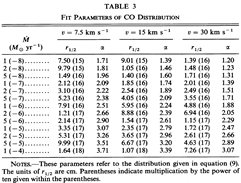
- (Bujarrabal et al., 1992A&A...257..701B)
Facts: They observed molecular lines CO 2-1/1-0, HCN J=1-0 and HCO+ J=1-0 lines toward several PPNs using IRAM 30m.
Opinions: Combining their observation with literature data, they found: 1) many PPNs are non-spherical; 2) CO 1-0 line strengths are tightly correlated with 60um fluxes: I(1-0) ~ 0.12 F(60um) for young PPNs, but the relation between I(1-0) and 25um fluxe is much worse; 3) molecular abundance is normal in IRAS 19114+0002 but very low in IRAS 18095+2704.
(figs: left -- CO 1-0 vs IRAS60um relation of PPNs; right -- the same for PPNs and AGBs)
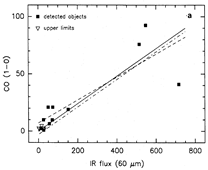 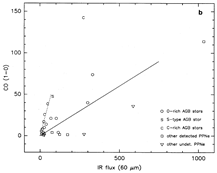
-
(Hu et al., 1994A&AS..103..301H)
A search of OH masers and CO line emission towards 62 PPN candidates
resulted in 16 detections of CO lines (using
JCMT) and 31 detections of OH masers (using
Nancay). Average Vexp = ~15 km/s. Most of the
OH maser sources are not variable over 1-5
years! A peculiar OH/IR star, IRAS 20406+2953,
shows variation of circular polarization.
- (Vassiliadis & Wood, 1994ApJS...92..125V)
Facts: They computed stellar evolution models in post-AGB stage for initial masses: 0.89, 0.95, 1.0, 1.5, 2.0, 2.5, 3.5, and 5.0 Msun and metallicities 0.016, 0.008, 0.004, 0.001.
Opinions: The post-AGB evolution sequences fall into two distinct groups: that dominated by H-burning shell and that dominated by He-burning shell. Low mass models are more likely to leave AGB burning helium.
(figs.: PN nuclei evolution tracks from Teff = 10^4 K (left to right: differnet z values); upper row -- H burning models; lower row -- He burning models. Each track is marked by the (initial mass, core mass) of the model.)
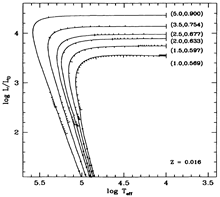 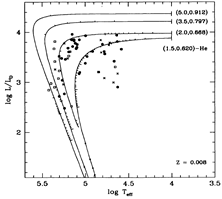 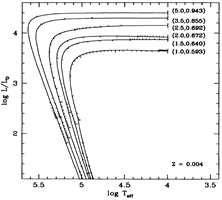 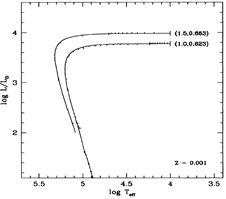
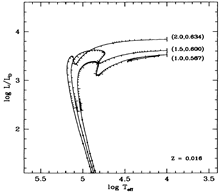 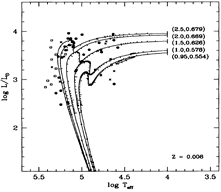 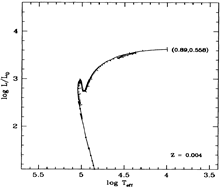
- (Bloecker, 1995A&A...299..755B)
Facts: With an improved AGB mass-loss law, they computed stellar evolution models from ZAMS through the AGB and post-AGB stages for initial ZAMS masses: 1, 3, 4, 5, and 7 Msun and initial metallicity (X, Y, Z) = (0.739, 0.24, 0.021). Their adopted mass-loss law is:
RGB:  (Reimers 1975), with eta_R = 0.5 for 1 Msun model, while eta_R = 1.0 for all other more massive models and during He-burning.
L, R and M are luminosity, radius and mass of the central star in solar units. (Reimers 1975), with eta_R = 0.5 for 1 Msun model, while eta_R = 1.0 for all other more massive models and during He-burning.
L, R and M are luminosity, radius and mass of the central star in solar units.
AGB: First determine the foundamental mode pulsation period P0 by:  , where M is the central star mass, R is the stellar radius, both in solar units. (Ostlie & Cox, 1986). , where M is the central star mass, R is the stellar radius, both in solar units. (Ostlie & Cox, 1986).
If P0 < 100 days, still apply the Reimers formula as for RGB above;
If P0 > 100 days, apply the Bowen (1988) formula:  , where the term 4.83x10^-9 M_ZAMS^-2.1 was introduced to ensure smooth transition from the Reimers formula to Bowen's formula at P0 = 100 days. , where the term 4.83x10^-9 M_ZAMS^-2.1 was introduced to ensure smooth transition from the Reimers formula to Bowen's formula at P0 = 100 days.
Post-AGB: the mass-loss law is unclear. Arbitrarily linearly reduce the post-AGB mass loss rate from the AGB one to a Reimers one with decreasing period from P0 = 100 days to 50 days, say,  , with , with  and t1 and t2 being the time of the beginning and end of the arbitrary reduction respectively (t1 < t < t2). After t2, the Reimers formula was applied until Teff amounts to 20000K after which the radiation-driven wind theory of Pauldrach et al. (1988) was adopted for the remaining part of the post-AGB evloution: and t1 and t2 being the time of the beginning and end of the arbitrary reduction respectively (t1 < t < t2). After t2, the Reimers formula was applied until Teff amounts to 20000K after which the radiation-driven wind theory of Pauldrach et al. (1988) was adopted for the remaining part of the post-AGB evloution:  . .
Opinions: They found that the post-AGB transition time strongly depends on treatment of mass loss beyond AGB. The post-AGB fading time was also found to be closely connected with AGB history. They have given the central star evolution tracks (started from postAGB stage when T* ~ 6000K) in online tables in Vizier (click here)
(figs:
upper row: left -- (Fig. 7, online table 3) for models (3, 0.605), (3, 0.625), (5, 0.836) Msun and times are in 1000yrs; middle -- (fig. 8, online table 4) for models (4, 0.696), (7,0.940) Msun; right -- (fig. 10) for model (3, 0.61), (5,0.84), (3,0.84) Msun;
bottom row:
left -- (fig. 14, online table 5) model (3, 0.625) Msun with one TP; middle -- (fig 15, online table 5) model (5, 0.836) Msun with one late TP; right -- (fig.16, online table 5) model (1,0.524) Msun with two late TPs.)
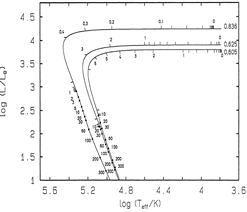 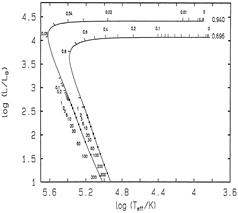 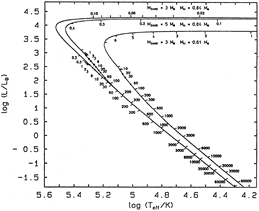
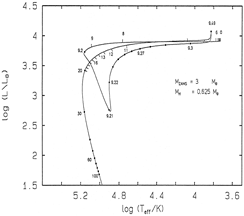 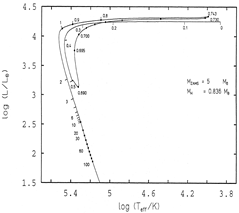 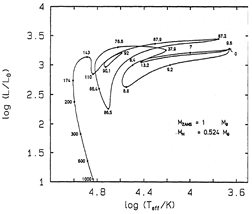
- (Huggins et al., 1996A&A...315..284H)
Facts: They presented CO 2-1/1-0 line observations of 91 PNe using IRAM 30m and SEST 15m..
Opinions: They found: The CO detected PNe (1) have massive gas envelope (0.01~a few Msun); (2) have N/O > 0.3 (3) have bipolar shape belonging to young disk population. CO/HI mass ratio decreases dramatically with increasing linear nebular size. The molecular envelopes remain a major component until nebular size exceeds 0.1 pc.
(figs.: left -- CO column density vs nebular size R; right -- CO to HI mass ratio vs nebular size R.)
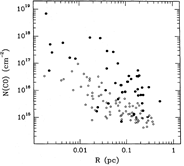 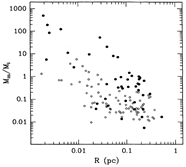
- (Knapp et al., 2000ApJ...534..324K)
Facts: They detected atomic CI line in three evolved stars (red rectangle, HD56126 and tentatively V Hya), increasing the number of evolved stars with known CI emission to severn.
Opinions: They found overwhelming CI emitters are C stars, suggesting that CI comes not from dissociation of CO but from other species. They also found that the CI/CO ratio increases along evolution sequence.
- (from Bujarrabal et al., 2001A&A...377..868B)
Facts: They studied the CO lines of all 37 well studied PPNe of which 16 have the CO lines observed by these authors themselves. Fast outflows are found in 28 objects, while it's absent from only 4 objects.
Opinions:
They present a method to estimate mass, scalar momentum, kinetic energy of different components of the sources: They adopted typical abundances of X(12CO) = 2x10^-4 and X(13CO) = 2x10^-5, typical Tex = ~15K for CO in post-AGB stars, intermediate inclination angle i=30 deg for jets; . They found that the nebular is usually massive (~ 1 Msun), with previous heavy mass loss rate (~10^4 Msun/yr). The momentum of the slow wind is comparable to that can be supplied by radiation, while the momentum of the fast winds are usually too high to be supported by radiation pressure, sometimes 1000 larger than highest available radiation momentum. This indicates that the fast winds should be driven by other mechanism than the radiation pressue.The typical momentum is 10^37 ~ 10^40 g cm s^-1, the typical kinetic energy is 10^44 ~ 10^47 erg, with higher values for more massive objects such as yellow hypergiants.
- (Liu et al., 2001MNRAS.323..343L)
ISO LWS spectroscopy revealed several PPNe/PNe with exceptionally massive PDRs: young PPN NGC 7027, bipolar nebulae M2-9 and NGC 6302, the young dense planetary
nebulae BD+30°3639, IC
418 and NGC 5315, and the old,
probably recombining, nebulae IC 4406 and NGC 6072.
- (Van Winckel, H. 2003, ARA&A, 41, 391)
Review of post-AGB stars: Refractory elements are deficient in some post-AGB stars' atomsphere
support the idea of re-accretion of circumstellar matter.
- (Woods et al., 2005A&A...429..977W)
Facts: They surveyed 230 and 345 GHz bands of two PPNs (IRAS 16594-4656 and IRAS 17150-3224), detected CO, 13CO, HCN, CN. They find that the abundance of them are lower than typical molecular rich PPNs such as CRL618, CRL2688, OH231.8+4.2.
Opinions: They summarized that 1) CN/HCN should increase with PPN age; 2) HCN/CO, CS/CO, HC3N/CO, SiO/CO, SiCC/CO should decrease with PPN age; 3) HCO+ is enhanced in PPN with unknown reason. They estimated age of 200-400 yrs for the two PPNs. They proposed that the deficit of molecular gases is due to the tenuous CSE withouth protective tori.
- (Huggins et al., 2005ApJS..160..272H)
Facts: They surveyed CO 2-1 to a sample of 110 PNs (most only the Galactic plane) and detected it in 40 of them. They find that the CO line widths of PNs (mostly 30-60 km/s) are much larger than AGB stars (typically 10-30 km/s), and many of them show extended line wings that indicates high velocity outflows.
Opinions: They extended the sample of PNs with CO detections. Array receivers is a big advantage for overcome interstellar contamination.
- (Hrivnak & Bieging, 2005ApJ...624..331H)
Facts: They surveyed CO 2-1 to a sample of 22 PPN candidates and detected it in 12 of them. Seven sources are also detected in CO 4-3.
Opinions: They find that the mass loss rate was increasing with time in the end of AGB (CSE density profile ~ r^-3), with mass loss rate at the end of AGB being several 10^-5 Msun/yr. CSE masses close to the star is 0.02-0.3 Msun, which is lower than determined from IR data. Seven of the 9 C-rich detections show 21um features, perhaps the 21um feature sources are richer in gas.
- (Kelly & Hrivnak, 2005ApJ...629.1040K)
Facts: They surveyed NIR H2 and hydrogen Br_gamma emission lines toward 51 PPNs in the northern sky and found 22 detections among which 7 show H2 emission only, 6 show Br_gamma emission only, 8 show both, and another one showes both and NIR CO emission. They found that most of the H2 detections are either B spectral type PPNs or bipolar PPNs of other spectral types. They also compiled all PPNs known with H2 detections to date.
Opinions: They concluded that the H2 emitters can be divided into two types: 1) F-G spectral type bipolar nebulae with an optically thick equatorial region, with H2 excited by collisions; 2) almost all B spectral type PPNs with H2 excited by radiation or by mixture of radiation and collisions. The first type H2 emission occurs in the bipolar outflows, while the second type occurs in spherical PPNs when the H2 begins to be destructed by stellar UV photons when the central star evolved to B-type.
- (Fong et al., 2006ApJ...652.1626F)
Facts: They did a small imaging survey of CO 1-0 to a sample of 8 evolved stars (2 AGB, 5 PPN, 1 PNs) using the BIMA and ARO12m. Combining with literature maps, they made a bigger sample of 38 sources with images.
Opinions: They classified the morphologies of the CO maps into three types: 1) spherical/elliptical/shell sources; 2) disk sources; 3) structured outflow sources. They find strong evidance of photodissociation from AGB to PN.
- (de Ruyter et al., 2006, A&A, 448,
641)
They reviewed the detection of a NIR excess due to dust at temperatures
close to that of sublimation, which should correspond to stable structures (i.e. in keplerian rotation) close to the star. 51 such objects are given in
the review. Binarity is
necessary to supply enough angular momentum to maintain the stable
structures.
- (Reyniers et al., 2007A&A...471..247R)
Optical spectral
observation and atmosphere modeling
of two post-AGB stars with slightly sub-solar composition show strongly carbon and s-process enriched
material (IRAS 08281-4850 and IRAS 14325-6428, with heavy carbon rich mass loss envelope and a stellar temperature of 7500K). Together with known similar
post-AGB stars without any enrichment, it is demonstated that we are still lack of
knowledge about the chemical properties of AGB stars.
-
(Lloyd Evans & van Winckel, 2007IAUS..240..682L)
Photometry and radial velocity observation of 6 F-type post-AGB stars showed that all of them are
binary systems with IR color typical of disk. Many of them (and more other post-AGB stars shown in the same paper) have
large binary eccentricity but short period (116-2600 days), contradicting with the theoretic conclusion from Bonacic Marinovic
& Pols (2004) that orbits below 3000 days should be absent. The six new F stars include: IRAS 08544-4431, EN TrA,
IRAS 12222-4652 (HD 108015), IRAS 19157-0247, (another two not mentioned).
- (Deroo et al., 2007A&A...474L..45D)
IR interferometer AMBER and MIDI mapping in K and N bands reveals
an asymmetry in the dust environment of the
post-AGB star IRAS 08544-4431. The model of a passive irradiated disk reproduces both K and N band
visibility and closure phase well.
- (from Sahai et al., 2007AJ....134.2200S)
HST images of all 23 well-resolved PPNs (another 5 unresolved) are reported. Wide variaties of non-spherical morphologies of these
PPNs are similar to that of young PNs. Prominent halos are found around central aspherical shapes in many objects, which represent
intact AGB CSEs. No round PPN is found, which demonstrates that the aspherical morphology of PNe has appeared before PN stage, instead of
being created by wind interaction. A new PPN morphology classification system
is suggested. The 23 PPNs and another 32 previously studied and resolved PPNs are classified.
(figure: A new PPN classification
system.)
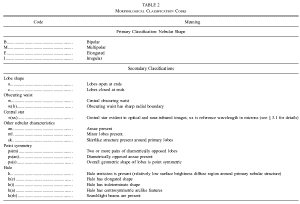
- (Lee et al., 2007ApJ...665..341L)
Facts: In order to search for ionized radio jets from PPNe, they mapped 16 bipolar nebulae with narrow waist at 1.3 and 0.7cm using VLA or at 6 and 3.6cm using ATCA. Strong central ionized core is detected in two northern objects (19W32 and M1-91) and three southern objects (He 2-25, He 2-84,
and Mz 3).
Opinions: these radio cores might be ionized outflows that shapes the PN.
- (Gomez et al., 2008arXiv0803.1644G)
VLA observations of H2O masers to 3 H2O maser
PPNe (IRAS 17443-2949,
IRAS 17580-3111, and IRAS
18061-2505) were reported.
Radio continuum emission was found only in IRAS 18061-2505, hence it is the 3rd confirmed H2O maser PPN. OH masers were detected only in two stars: IRAS 17443-2949 and IRAS
17580-3111, and other two stars in the same field of view ( IRAS 17442-2942, with unknown nature, and IRAS 17579-3121, also cataloged as a possible PN). The 3 known H2O maser PPNs all show bipolar morphology.
Water fountain stars could be their precursors. The nature of other OHPPNe
also need mapping and continuum data to confirm their nature.
- (Blackman, 2008arXiv0812.2525B)
Magnetic fields in PNe are discussed:
- Typical conditions of fast winds in PPNs: age ~
10^2-10^3 yr, Vexp ~ 50 km/s, mass ~ 0.5 Msun, Mlr ~ 5x10^-4 Msun/yr, mechanic momentum ~ 5x10^39 g.cm/s, mechanical Lm,f >= 8x10^35 erg/s.
-
Typical conditions of slow wind in PPNs: age ~ 6x10^3
yr, Vexp ~ 20 km/s, mass ~ 0.5 Msun, Mlr ~ 10^-4 Msun/yr, mechanic momentum ~
2x10^39 g.cm/s, mechanical Lm,s ~ 10^34
erg/s.
-
Typical conditions of slow winds in PNe: age ~ 10^4 yr, Vexp ~ 30 km/s, mass ~ 0.1 Msun, Mlr ~ 10^-5 Msun/yr, mechanic momentum ~ 6x10^38 g.cm/s, mechanical Lm,s ~ 3x10^33 erg/s.
-
Typical conditions of fast winds in PNe: age ~ 10^4 yr, Vexp ~ 2000 km/s, mass ~ 0.0001 Msun, Mlr ~ 10^-8 Msun/yr, mechanic momentum ~ 4x10^37 g.cm/s, mechanical Lm,f ~ 1.3x10^34 erg/s. (conditions
from Bujarrabal et al., 2001)
- (Hrivnak et al., 2009ApJ...694.1147H)
Spitzer IR spectroscopy of seven PPNs between 10-36um with a resolving power of R~600 showed that the unidentified 21um and 30um features and aromatic infrared band (AIB at 11.3, 12.4, 13.3um) appear ubiquitously in all seven PPNs. The 21um feature showes similar profiles and thus could be from a common carrier. The 30um feature, however, was not resolved into two components at 26 and 33um, as proposed before from ISO spectra. Five PPNs showed 13.7um feature of C2H2, one PPN was in absorption, while the other four are in emission. Four PPNs show unidentified feature around 15.8um.
- (Hrivnak et al., 2010ApJ...709.1042H)
Facts: They present long term (14years) V and R band monitering of 12 C stars. All show variation of magnitude and color. The light curves are complex, indicating multiple periods or varying pulsation properties (period, amplitude, etc). Inverse correlation between P-Teff and Amp-Teff are found.
Opinions: The decrease of AGB super wind mass loss may start earlier than previously thought, because it has started at P=150 days in the observed objects, instead of starting when P<100 days. This further indicate that the decrease of mass loss rate during the early post-AGB stage may be slower than previously thought and thus extending the post-AGB evolution time. The fast change rate of periods dP/dt = -0.17 day/yr makes the post-AGB evolution effects detectable within 2-3 decades.
Binary and Disk (back to top)
- (Ueta et al., 2000ApJ...528..861U)
Facts: They report an optical HST image survey of 27 post-AGB stars to investigate the distribution of circumstellar dust.
Results: Nebulosities are detected around 21 of the 27 objects. The morphologies can be classified into two groups: SOLE -- star-obvious low-level-elongated nebulae and DUPLEX -- dust-prominent longitudinally extended nebulae.
Opinions: (1) SOLE type PPNs are low mass objects with optically thin CSE; DUPLEX PPNs are more massive objects with optically thick CSEs.
(2) The SOLE objects should not be pole-on version of DUPLEX objects, because 1) the nebulosities in the pole-on case is usually difficult to observe due to the severe PSF contamination; 2) tilted DUPLEX object should show off-center central star, which is not widely seen among the SOLE samples.
(3) The morphological types are not correlated with the chemical types of C and O.
(4) The difference between the DUPLEX and SOLE types can not be explained with different post-AGB ages, because the central star spectral types do not support this.
(They did not discuss the role of binarity.)
- (Calvet et al., 2002ApJ...568.1008C)
Facts: They constructed a truncated disk model to successfully explain the SED of a 10 Myr old T Tauri star TW Hya.
Opinions: A outer cold disk with large grains (size ~1 cm) of 0.06 Msun mass and 140AU size is needed to reproduce the FIR excess; an inner evacuated hole inside <= 4AU is needed to reproduce the NIR dip; a warm wall near the inner surface of the outer disk is required to reproduce the MIR exccess; however, a much lower mass of hot smaller particles (size ~1 um) of 0.5 Mlunar is still needed inside the inner evaculated region to reproduce the 10um silicate feature.
(fig.: disk model fit to the SED of TW Hya; The SED conponents are (increasing wavelength): central star, hot inner disk, the wall, the outer cooler disk.)
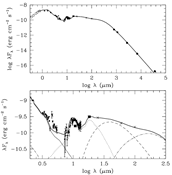
- (Bujarrabal et al., 2003A&A...409..573B)
Facts: The CO maps show a thin orbiting gas disk arround Red Rectangle, extending 5" in the direction perpendicular to the symmetry axis of optical nebula. The velocity dispersion increases towards the centre.
Opinions: They detected a Kepler-like rotating and slowly expanding disk around Red Rectangle. This is the first detection of a gas disk around a PPN.
- (D'Alessio et al., 2005ApJ...621..461D)
Facts: They constructed a truncated disk model to successfully explain the Spitzer IRS spectrum (8-25um) of a young PMS star (~1 Myr) CoKu Tau/4.
Opinions: The MIR spectrum is mainly explained by an inner wall of the truncated disk at a radius of ~10AU with a half-height of ~ 2AU. A cooler and optically thick outer disk is necessary but less constraint due to the lack of FIR data. Different from previous case of the much older T Tau star TW Hya, there is no need of hot inner disk in this case. The silicates features can be reproduced using Fe-Mg amorphous classy olivine and/or Pyroxene grains. No crystalline silicate features are found in the observed spectrum.
(fig.: disk inner wall model fit to the SED of CoKu Tau/4. The two curves correspond to different reddening laws applied. The wall model: T0=140K, cos i =0.45, H_wall = 240 R*, grain size amax = 0.25 um, glassy pyroxene with 20% Fe and 80% Mg with small amount of organic and troilite grains.)
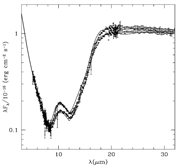
- (de Ruyter et al., 2006A&A...448..641D)
Facts: They perform a houmogeneous and systematic study of the SEDs of a sample of 51 post-AGB stars to show that some broad band SEDs should be best explained with the circumstellar
dust stored in Keplerian rotating passive discs.
Results: All considered SEDs show NIR excess starting near the sublimation temperatue, while the long wavelength parts show a black body slope indicative of the presence of a component of large mm sized grains.
Conclusions: (1) The NIR excess from hot dust is a strong indication of circumbinary dust discs;
(2) the binary orbit sizes are too smaller than the size of typical AGB stars, indicating active binary interaction has occurred and affected (accelerated) the evolution of the AGB stars;
(3) many of the orbits are eccentric, which are poorly understood;
(4) binaries are common in (post-)AGB stars;
(5) RV Tau stars those evolved binaries which happen to be in the Population II Cepheid instability
strip.
(6) the difference between binary post-AGB stars and YSOs is that the former have bluer mid- and far-IR colors and thus should have more compact circumbinary discs than the passive discs around YSOs.
- (Nordhaus et al., 2008MNRAS.388..716N or 2008arXiv0801.2978N)
Facts: He conducted Shell model and edge-on disk
model fitting of SED from optical to submillimeter post-AGB star HD 17982.
Opinions: He demonstates
that data longer than 40um is necessary to
differentiate the two models. The good fit of HD 179821 indicates that it is an evolved star
with hollow spherical circumstellar shell instead of edge-on circumstellar disk.
(figure: left bad SED fit with disk
model; right -- good SED fit with hollow shell model.)
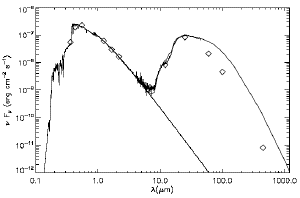 _ _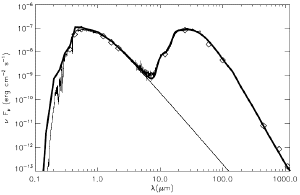
- (Van Winckel et al., 2009A&A...505.1221V)
Facts: They monitored six post-AGB stars of F type spectrum that are small amplitude pulsators showing NIR excess at J, H bands. The multi-band photometric and radial velocity monitoring allowed them to determine the orbital parameters.
Results: All six stars are binaries with P = 120-1800 days, with five of them have non-circular orbits.
Conclusions: (1) Circumbinary discs around post-AGB stars should be formed during a strong binary interaction phase.
(2) Confirm that binary evolved stars creat Keplerian disks;
(3) circumbinary discs have major impact on the evolution of binary system (shorten the AGB life time), judging from the measured orbits and mass function;
(4) these binary post-AGB stars should be taken as post interacting binaries, instead of cannonical post-AGB stars;
(5) the large eccentricity of some post-AGB binary systems can not be explained with standard binary evolution channels.
|
| |
Outflows (back to top)
- (Corradi et al., arXiv:1102.5634)
Facts: They followed the evolution of the outflows in M2-9 with sub-arcsec resolution imaging and spectroscopy in the past decade.
Results: They analyzed the observed rotation of the corkscrew pattern of the outflow and demonstrate that the pattern is caused by ultra-fast (11000-16000 km/s) rotating jets from a central sybiotic-like interacting binary system, instead of by leaking ionizing radiation.
(figs: 1--Halpha + NII image, 40''x140''; 2 -- OIII, NII images and model, 20''x64'', (June 2001); 3 -- time series of the [OIII] images, 14.5''x64''; 4 -- time series of the [NII] iamges, 14.5''x64''.)
 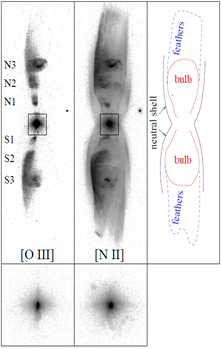 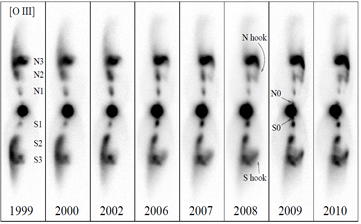 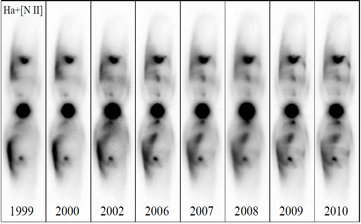
Hydrohynamics
(back to top)
- (from Icke et al., 1992A&A...253..224I)
Facts: They present 2-D hydrodynamic model for the early evolution of aspherical PPNe. A pre-existing axisymmetrical CSE is assumed into which a high velocity jet is fed.
Opinion: They find that (1) in the early stage of post-AGB phase (<500yr), the velolution of the nebula is highly sensitive to the density distribution of the pre-existing AGB CSE; (2) the interface between the two winds consists of three components: inner reverse shock around the equator region, outer shock propogating into the CSE, and a contact discontinuity between the two; (3) the deflection of the inner shock off the equatorial belt help focus the fast wind to the bipolar regions; (4) the equator-to-pole density contrast α determines the timescale of the apherical pattern developement, while the steepness of the desity gradient from equator to pole β controls the collimation degree of the bipolar outflow; (5) small β (<2) produces elliptical or peanut nebulas and non-spherical inner shock, while large β produces collimated bipolar jets and more spherical inner shock (the auto-collimation is achieved through the entrainment of cold gas into the hot wind to form a narrow chimney and the backward expreading of the outer hot shocked gas around the cold chimney).
(fig: left to right -- density distribution of two wind interaction model at 444 year after the launch of the fast wind with density steepness β = 1, 3, 6, respectively.)
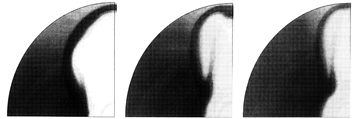
- (Mastrodemos & Morris, 1998ApJ...497..303M)
Facts: They constructed a 3-D SPH model to explore the formation of accretion disk around the companion of a detached AGB binary system.
Opinion: They found that (1) the red giant wind in a detached binary system with small to intermediate separation (3-6 primary radius) can form a permanent accretion disk around the companion star; (2) the accretion disk shares with steady state disk some characteristis such as Keplerian motion in the inner disk, thin disk because of effective cooling, but one of the biggest difference is that the outer part of the accretion disk in the model has supersonic radial velocity; (3) the inner disk could be slightly warped when the binary separation is large, perhaps due to disturbance of the gas velocity along the axis direction; (4) the accretion produces a stable wake behind the secondary, but it never survives out to large radius to forma spiral shocks.
(figs: left -- the velocity field in the stable accretion wake on the orbital plane (co-rotating coordinate); right -- the velocity field on the accretion disk plane (co-rotating coordinate).)
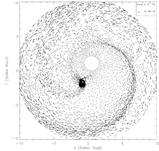 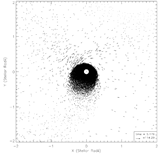
- (Mastrodemos & Morris, 1999ApJ...523..357M)
Facts: They constructed a 3-D SPH model to explore the effects of wide binary motion to the AGB circumstellar envelope, so as to discuss the possible consequence in shaping non-axisymettrical PPNe. They explored the parameter space of wind velocity 10-26 km/s, circular orbit diamter 3.6-50 AU, binary companion mass 0.25-2 Msun.
Opinion: They found that the increase of wind velocity Vw (at the secondary's orbit) or orbit size d is equivalent to reduction of companion mass Ms. Increasing Vw or d or reduction of Ms will consecutively result in three types of CSE morphologies: bipolar, elliptical, quasi-spherical, which are defined by their equator-to-pole density contrast: >10, 5-10, and <5, respectively. The quasi-spherical morphology is the preveilling type in the parameter space. The best parameter to tell the three morphologies is Racc^1/d where Racc^1 = 2GMs/Vw^2. This can be seen in the figure below. Another equivalent parameter is Vp/Vw, where Vp is orbital velocity of the primary, because (Vp/Vw)^2 ~ (Racc^1/d). Another similarly good morphology indicator is the focusing parameter alpha_foc = Mlr_acc/Mlr, but the velocity in the formula is better to be replaced by Vw. Alpha_foc is > 0.07~0.1, 0.03~0.07 and <0.03 for bipolar, elliptical and quasi-spherical respectively. Concentric shells or spiral shocks can be seen in the quasi-spherical case which are produced by the motion of the primary star. From binary statistics, about 34-40% of detected binaries will show bipolar shape for a wind velocity of 10 km/s. An interesting finding is that accretion disk can form in detached binary at fairly large radius, e.g., 24AU. They find that the density contrast is always accompanioned by outflow velocity gradient over latittude, say, the gas outflow velocity in the polar direction is slower than the equatorial direction in the bipolar case, however, the dust velocity could in reverse trend due to higher drift velocity in the polar direction. This is the result of less efficient momentum transfer in the dust-gas coupling for lower gas density. They also give polynomial fitting to the latittude density profiles for some models. They also warn that the dust-to-gas ratio could also be latittude dependent due to the non-uniform dust formation above the photosphere and the tidal distorsion of an AGB star in a binary system.
(fig: the relation of density contrast and Racc^1/d)
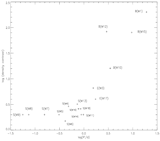
- (Matt et al., 2006ApJ...647L..45M)
Facts: They did MHD simulations for a rigid rotating magnetized stellar core to expel the envelope material by magneto-rotational explosion.
Opinions: They found that the model can produce bipolar jets and an equatorial outflow simultaneously. This mechanism might be applicable to Type II SNe, gamma-ray bursts and PPNe.
(figs.: left -- magneto-rotational explosion producing bipolar jets plus equitorial outflow; right -- the B-field lines in the explosion.)
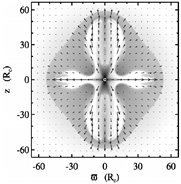 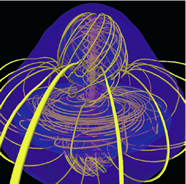
- (from Nordhaus & Blackman, 2006MNRAS.370.2004N)
Facts: They did MHD simulations to explore the possible ways of common envelope (CE) evolution of a giant star (RGB or AGB) with a low mass companion (planet, brown dwarf, low mass MS star).
Opinions: They find that the CE evolution can result in three possible consequences: 1) (e.g., a brown dwarf companion) direct ejection of envelope material through equitorial outflow; 2) (lower mass companion) spin-up of the envelope material results in an explosive dynamo-driven jet; 3) tidal shredding of the companion resulting in disc-driven jet.
(fig.: Carton of the three consequences of CE evolution with a low mass companion.)
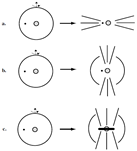
-
(from Huggins, 2007ApJ...663..342H)
He compiled 9 most studied PPNe with clear detection of both jets and tori. By treating the apparant r/v as the lifetime of the jets and tori, he found that jets and tori usually have comparable lifetimes, while jets apparantly seem to be systematically younger than tori by a few hundred years. He systematically examined many candidate mechanisms that have the potential to produce either jets or torus or both in evolved stars. (my notes: the torus lifetime could be evenlonger than the apprant values because the gas can freely flow through the torus-like structure. Moreover, the kinematics of the torus could be more complex than a simple expansion motion.)
- (from Dennis et al., 2008ApJ...679.1327D)
Hydrodynamic simulations were performed to
compare between jet and bullet model for PPN bipolar outflows. They found that bullet model produces slimmer bipolar lobes with a V-shaped
caps, while continuous jet model produces fatter bipolar lobes with U-shaped caps. This
difference could be used to differentiate the two models in observations.
- (from Haro-Gorzo et al., 2009ApJ...703L..18H)
Facts: They model the effect of eccentric orbit motion of the secondary (jet launcher) to the morphologies of the jets created circumstellar pattern asymmetry.
Opinion: They found that the varying orbit motion velocity can have effect in the jet morphology and make the jets show point- or mirror- symmetry at different viewing angles.
|
SED evolution (back to top)
- (Szczerba & Marten, 1993ESOC...46...90S)
Facts: They computed SED evolution tracks on IRAS c-c diagram for late AGB and post-AGB stars with different dust grains, post-AGB mass loss rate, AGB CSE density law, and central star mass.
Conclusions: 1) For the late-AGB evolution, both high mass and low mass AGB stars evolve through similar IRAS c-c diagram region; 2) the post-AGB evolution tracks on the diagram is sensitively dependent upon post-AGB mass loss rate and the moment of superwind cessation.
(figs.: (IRAS c-c diagram of late-AGB and post-AGB evolution)
upper left (late-AGB, silicates, 0.598 vs 0.836 Msun) -- left: with constant supperwind mass loss rate; right: with increasing supperwind mass loss rate;
upper right (late-AGB, AC dust, 0.598 vs 0.836 Msun)-- left: with constant supperwind mass loss rate; right: with constant supperwind mass loss rate;
lower left (post-AGB, Sil vs AC) -- left: with lower post-AGB mass loss rate; right: with higher post-AGB mass loss rate;
upper right (hydrodynamic sequence)-- left: late-AGB evolution; right: post-AGB evolution.)
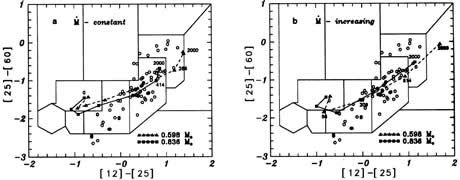 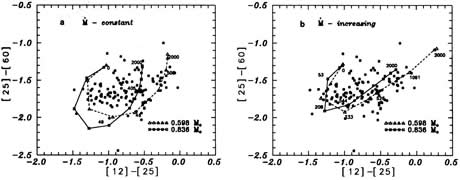
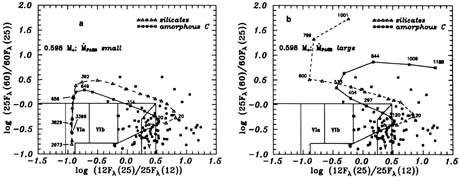 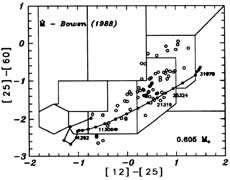 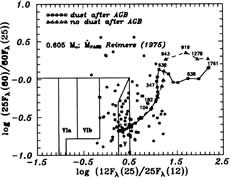
RV Tauri stars
(back to top)
-
RV Tauri stars are a limited sample of stars showing alternative
deeper and shallower minima in their light curves. They could be post-AGB stars in binary systems. But their nature
and the real cause of the peculiar light curve is still in debate.
-
Nonlinear pulsations model of the RV Tauri stars
seems to be able to explain the alternative minimua of the light curve.
(from Fokin, A. B., 1994A&A...292..133F)
-
Observation of optical spectra and radial velocity were reported for RV
Tauri star R Sct. It was shown that there are two
shock waves in the star. (from Gillet et al., 1989A&A...215..316G)
|
High galactic latitude supergiants
(back to top)
-
Stellar surface abundance analysis showed that the supergiant HD 27381 has atmospheric parameters and abundance
pattern similar to post-AGB star HD 107369, HD 10285 and HD 25291
are moderately metal-poor
and show the influence of mixing that has brought the products of NeNa cycle to the surface. The B supergiant HD 137569 shows selective
depletion of refractory elements. The high velocity B type star HD 172324 shows moderate deficiency
of Fe group elements but the CNO abundances are
very similar to that of disk B supergiants (could be a pulsating variable or
binary star). (from Giridhar & Arellano, 2005A&A...443..297G)
-
OH maser was detected in the high galactic
latitude early-type supergiant HD 101584. (from
Te Lintel Hekkert & Chapman, 1996A&AS..119..459T)
|
Examples of of PPN/postAGB (back to top)
- CRL 2688
- (EGG NEBULA) (IRAS Z21003+3630? from Torun PPN catalogue.)
- IRAS 04395+3601 - (CRL 618) - one of the
well studied PPN.
-
IRAS 07134+1005 -- a 21um emission C-rich
post-AGB star recently explored using SMA in CO 3-2 as an exanding torus
without jets. The relation among expanding torus, lack of jets, 21um
emission deserves further study.
(Nakashima et al., 2008)
-
IRAS 07399-1435 (OH
231.8+4.2, Rotten Egg Nebula) -- a
bipolar nebula showing broad OH 1667 MHz maser profiles with large expansion
velocity of 50 km/s. (Morris & Bowers, 1980)
- IRAS 07430+1115 -- A high galactic latitude post-AGB star.
- IRAS 09371+1212 (Frosty Leo) - A well known high galactic latitude bipolar PPN.
- IRAS 10158-2844 - (HR 4049) - a single line
binary post-AGB star with peculiar chemical composition (due to accretion).
(Hinkle et al., ApJ, 2007, accepted)
- IRAS 12067-4508 - (RU Cen) - an RV tauri star.
- IRAS 12419-5414 - (Boomerang Nebula, Centaurus bipolar nebula)
-
IRAS 17112-1251 -
(NGC 6309) a PN showing point symmetry in it CSE. It was formed by a set
of well-collimated bipolar outflows (jets) (from Vazquez et al., 2008arXiv0801.4601V)
-
IRAS 17381-1616 -- very young PPN found to
show bipolar structures ~0.2" apart by VLA continuum mapping (from
Corrigone et al., 2008MNRAS.tmp..994C)
-
IRAS 17443-2949 -- a candidate PPN showing H2O masers and OH masers (VLA) (from Gomez et al., 2008arXiv0803.1644G)
- IRAS 17534+2603 - (89 Her) -a low mass
post-AGB star.
-
IRAS 17580-3111 -- a candidate PPN showing H2O masers and OH masers
(VLA) (from Gomez et al., 2008arXiv0803.1644G)
-
IRAS 18061-2505 -- a PPN showing H2O masers but no OH maser, the PPN nature was
confirmed by continuum emission (VLA). (from Gomez et al.,
2008arXiv0803.1644G)
- IRAS 18281+2149 - (AC Her) - an RV tauri star
-
IRAS 18442-1144 -- very young PPN found to
show bipolar structures ~1" apart by VLA continuum mapping (from
Corrigone et al., 2008MNRAS.tmp..994C)
-
IRAS 19336-0400 -- very young PPN found to
show bipolar structures ~1" apart by VLA continuum mapping (from
Corrigone et al., 2008MNRAS.tmp..994C)
-
IRAS 19343+2926 (PN M
1-92, Minkowski's footprint) -- a
bipolar nebula showing broad OH 1667 MHz maser profiles with large expansion
velocity of 25 km/s. (Morris & Bowers, 1980, Bujarrabal et al., 1997A&A...320..540B)
- IRAS 19437-1104 -- a high galactic latitude post-AGB star.
- IRAS 19500-1709 -- a high galactic latitude post-AGB star.
-
IRAS 19590-1249 -- very young PPN found to
show bipolar structures ~1.5" apart by VLA continuum mapping (from
Corrigone et al., 2008MNRAS.tmp..994C)
-
IRAS 22023+5249 -- very young PPN found to
show bipolar structures ~2" apart by VLA continuum mapping (from
Corrigone et al., 2008MNRAS.tmp..994C)
-
IRAS 22036+5306
-- a bipolar PPN showing very low 12C/13C ratio.
-
IRAS 23541+7031
-- a bipolar PPN
- NGC 7027 - a young PN showing strong molecular emission lines. Distance is
980+-100 pc and stellar mass is 0.655+-0.01 Msun (from Zijlstra et al., 2008arXiv0801.3327Z)
|
(back to top)
|
![]()